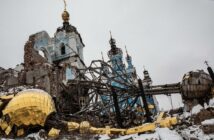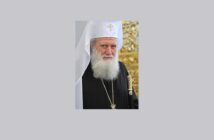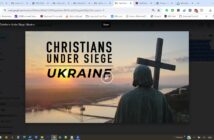Source: Public Orthodoxy
Rev. Bohdan Hladio
A Ukrainian Orthodox priest within the jurisdiction of the Ecumenical Patriarchate
As I write this, the drama surrounding the expulsion of the monks of the Ukrainian Orthodox Church under Metropolitan Onuphry from the Kyiv Pechersk Lavra is being played out, a drama simultaneously sad, understandable, and scandalous.
I first visited the Lavra in November of 1988. A portion of the monastery had just been re-opened, and it was moving to see how the monks were re-establishing monastic life after decades of Soviet persecution. One of the elderly monks “boasted” that he had been expelled from the monastery by three different Soviet regimes. While some see parallels between the experience of that elderly monk and the current controversy, I would argue that the parallels aren’t quite so straightforward.
I next visited the Lavra in 2006. The change was colossal. The small, poor, make-shift accommodations had been transformed into a spacious, opulent, and impressive space, with churches, cells, gardens, restaurants, and shops. Especially striking were the expensive luxury cars and SUVs of the clerics entering and leaving the premises, a big change from the poverty I had witnessed eighteen years earlier (I was reminded of a story related to me by a Serbian priest regarding Patriarch Pavle of blessed memory. The Patriarch, he said, when going to his first meeting with the Synod, looked out the window and saw a parking lot full of very expensive cars. “Whose cars are they?” he asked. “Your Holiness, those cars belong to the bishops,” was the answer. To which the Patriarch replied, “Hmmm … I wonder what kind of cars they would drive if they hadn’t taken a vow of poverty?”).
I visited the Lavra again in 2016, this time with my wife. By then, Kyiv was clearly a Ukrainian city. Whereas in 1988, the Russian language was de rigeur, and in 2006 it was still prevalent, by 2016, the dominant language on the street, in stores, restaurants, etc., was Ukrainian. Stepping through the gate of the Lavra, however, was like nothing so much as crossing the border into Russia. All the signage was in Russian, as were the overheard conversations. Inquiries made in Ukrainian at the various church goods stores or icon shops were greeted with suspicious glances and answered in Russian. When we went to tour the caves to venerate the relics, after paying our entrance fee, the ticket-seller said (in Russian), “You understand Russian, right?” and my wife immediately replied in Ukrainian, “No, we don’t. We would like the tour conducted in Ukrainian.” This elicited a flurry of whispering among the ladies on the other side of the counter and a phone call to someone else, after which we were told, “The tour can’t be offered in Ukrainian—will English be OK?” In 2016, twenty-five years after Ukrainian independence and two years after Russia’s initial invasion of Ukraine, it was “impossible” to find someone who could conduct a tour of the caves in Ukrainian, in the capital of Ukraine, at the epicenter of the “Ukrainian Orthodox Church.”
Why is the government evicting the monks now? I have no insider information, but I do read Ukrainian and Russian and follow the secular and ecclesiastical news from Ukraine, and it seems to me that it’s not any one reason but a confluence of several factors.
The first point to be made is that the government’s action is not a Soviet-style attack against religion per se, such as what the old monk I met in 1988 had faced. It is, rather, a definitely controversial and arguably immoderate response to what is perceived as an existential threat. The monks are free to continue to fulfill their monastic obediences, just not in this particular location. Why?
I believe that the main reason has to do with what I witnessed during the other two visits mentioned above: the opulence and affluence as well as the non-, if not anti-Ukrainian bias experienced by visitors to the Lavra over the course of decades. I do not know any priests in North America who can afford to drive the kinds of cars I saw priests and monks driving while at the Lavra. How could anyone—especially monastics!—afford such vehicles in a country where the average wage was less than $200 US dollars per month? Where was the money coming from? Likewise, for three decades, the lingua franca of the Lavra and the Ukrainian Orthodox Church affiliated with the Moscow Patriarchate was Russian, and the liturgical language was (and still is) Church Slavonic in the Russian (rather than Ukrainian) recension. Things like this get noticed, especially in a country going through the process of decolonization with a history of colonial oppression.
I have always been impressed by the reverence and love the Greek people—even not-terribly-pious Greek people—have for monasteries. Conversely, Orthodox Ukrainians would often look upon monasticism with skepticism, if not suspicion. Why? Whereas Greek monastics supported and participated in the struggle for national independence, monasteries in Ukraine for hundreds of years have been centers of colonial influence and power, largely staffed and led by monastics who were often of Russian derivation and always loyal to the Czarist or Soviet regimes. Revelations over the past six months about monastics and clergy of Metropolitan Onuphry’s jurisdiction spreading Russian propaganda and actively supporting the Russian invasion cannot help but feed pre-existing suspicions.
To my mind, the scandalous nature of this controversy is not due so much to the termination of the rental agreement between the Ukrainian government and the Onuphryite church in Ukraine but rather to the reaction (and lack thereof) on the part of many Orthodox churches and hierarchs to the Patriarch of Moscow’s support for the war in Ukraine. While the “Caves controversy” raises obvious and healthy questions having to do with things such as the Ukrainian government’s position on religious freedom, other, more theologically salient questions are notable in the Orthodox press by their absence.
Since the announcement of the Ukrainian government’s cancellation of the rental agreement, the Onuphryite church has been posting letters of support from various patriarchates and hierarchs for the monks as well as condemnations of the Ukrainian authorities on its website. It is difficult to read such texts, however, when hundreds of thousands of military personnel (Russian as well as Ukrainian!) as well as tens of thousands of Ukrainian civilians have been killed and wounded, when between one-third and one-half of Ukrainian citizens have had to flee their homes, and when civilians and civilian infrastructure are attacked on a daily basis by the Russian military—all with the enthusiastic blessing and support of the Patriarch of Moscow.
I would invite those who, of late, have become deeply concerned with the state of religious liberty in Ukraine to first study the state of religious liberty in Russia and the temporarily occupied territories. While the Onuphryite Church in Ukraine is not being banned, the existence of Ukrainian Orthodox (and other) Churches and cultural institutions in Russia is forbidden, along with many other religious, cultural, and human rights groups. The question I would propose to those who are so concerned about the state of civil rights in Ukraine is, “What have you done to support human rights in Russia?”
Likewise, I cannot help but wonder why it is that most, if not all, of the patriarchates and hierarchs who support the Onuphryite monks in Kyiv, have not been able to find the honesty and courage to openly and categorically condemn Russia’s unprovoked war and particularly the Patriarch of Moscow’s clearly anti-Christian support of it?”
Two reasons seem obvious. Silence can indicate assent or fear. In the given instance the “best case scenario” would be that the churches and hierarchs who have not categorically condemned the Patriarch of Moscow’s anti-Christian warmongering are simply afraid—perhaps of recriminations, loss of financial support, an “invasion” by the Moscow Patriarchate into their own canonical territory, etc. More disturbing is the thought that those who have not openly condemned the Patriarch of Moscow’s support for Putin’s genocidal war actually support it themselves.
Christ castigates the religious leaders of his community for “swallowing camels while straining out gnats” (Mt. 23). The controversy surrounding the cancellation of the rental agreement between the government of Ukraine and the Onuphryite church is, if nothing else, shining a very public light upon the churches and hierarchs who, while frantic over the “gnat” of controversy between the government and the monks, seem to have no problem swallowing the “camel” of the Moscow Patriarch’s anti-Christian warmongering. Until such time as all Orthodox churches, hierarchs, and clergy clearly, publicly, prophetically, and unequivocally condemn the support of the Moscow Patriarch and patriarchate’s support for Putin’s genocidal war against Ukraine, the Orthodox church will continue to lose credibility as a legitimate Christian body.




